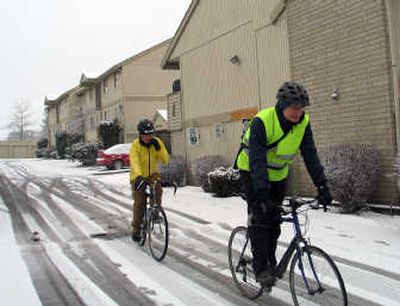City updating bike plan

The South Side’s Kevin Plummer stopped outside his apartment at 53rd and Regal before heading off on his six-mile daily commute to downtown – by bicycle.
“Why do I commute (by bicycle)? To save money. To keep fit,” he said as snow was falling from an early spring storm. “It’s a lot more fun than sitting in a car.”
Commuting by bike, even in wintry conditions, is perfectly safe, he said. He rides his bike to work, ironically, as an auto mechanic at a Volvo dealership.
On this particular trip, Plummer had company.
John Speare, of the Spokane Bicycle Advisory Board, followed Plummer to gather data on preferred bicycle commuter routes. Speare is using GPS tracking to log bicycle commuter habits, and is seeking to identify preferred routes. For example, Bernard Street on the South Side, which was rebuilt in recent years, is favored by bicyclists, along with the Centennial Trail, according to the GPS mapping available on the Web at bikespokane.net.
City planners are organizing public input to update the city’s 30-year-old master bike plan. A series of three open houses are scheduled for later this month to gather information from citizens.
“It’s critical right now we get people’s feedback,” said Speare.
The city’s master bike plan is included as part of its overarching comprehensive land-use plan for managing urban growth and traffic, and the bike plan is integral to reducing single-occupancy commuter trips.
When the City Council updated the land-use plan in 2006, officials made a commitment to bicycle advocates to update the bike master plan as a component of the comprehensive plan.
Ken Pelton, a city planner, said the city could eventually develop bike lanes with stripes on any number of arterials. The master plan could also advocate for improved trails such as a renovation of the unused “iron bridge” railroad span across the Spokane River east of Hamilton Street and north of Trent Avenue.
Also, Avista Corp. is looking at the possibility of constructing a trail tunnel underneath Mission Avenue where the Avista campus, BNSF Railway tracks, the river and city parkland converge.
The planning work adds specificity to grant applications to fund bike route projects, they said.
Spokane residents lag behind other cities when it comes to bicycle commuting in a study completed last November of four cities, including Minneapolis and Columbia, Mo., through the Federal Highway Administration.
The trailing number of commuters can’t be blamed on winter weather because Minneapolis has more than double the bike commuters of Spokane, Pelton said.
The study showed that 0.8 percent of the city population commutes by bike, compared with 2 percent in Minneapolis and 1.5 percent in Columbia.
Use of ride sharing is comparable at about 2 percent in all three cities. Four percent of Spokane residents use transit compared with 9.7 percent in Minneapolis and 2.2 percent in Columbia.
The update of the bike plan is being coordinated with a revision of the downtown master plan, work that is being done jointly by the city and Downtown Spokane Partnership. Also, an exhaustive traffic study of downtown circulation is addressing needs of bicyclists.
“The potential in Spokane is huge for a great bike infrastructure,” Pelton said.
Already, the proposed revisions of the downtown plan call for building new boulevard thoroughfares to carry vehicle drivers, pedestrians and bicyclists.
Other efforts are being made to enhance bikeways. Reconstruction of North Wall Street between Wellesley and Francis avenues starting this month will lead to elimination of parking on Wall, and the availability of using the outside portions of the lanes for bicycle traffic, Pelton said.
Increasing connections between favored bike routes is a priority for the planning work, officials said.
Bicycle advisory board members have been making the rounds of neighborhood councils to enlist their support in the master planning, they said.